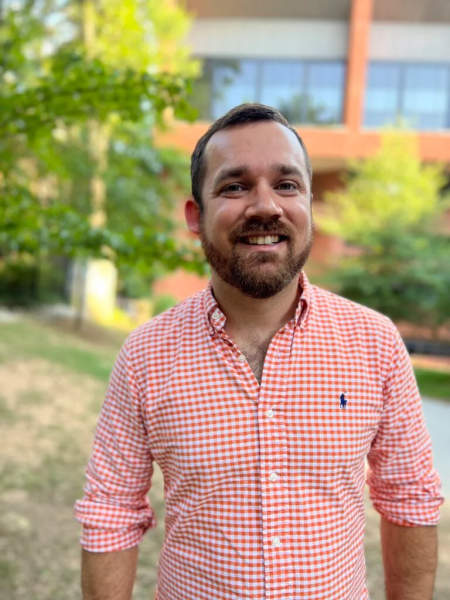Georgetown University’s department of physics hosted a talk titled “Watching the Earth Breathe from Space: What Glowing Plants Tell Us About the Global Carbon Cycle,” on Jan. 23 as part of their weekly seminar series.
Taylor Jones, an assistant professor at the Georgetown Earth Commons Institute, spoke at the event. Jones uses remote sensing techniques — acquisition of information about an object or phenomenon without making physical contact with the object — to investigate man-made greenhouse emissions and plants’ role in absorbing these emissions.
Jones said his commitment to understanding and mitigating climate change underlies his passion for scientific research.
“What is motivating everything I do is global climate change, greenhouse gas emissions and what’s happening with them,” Jones said at the event.
To measure the extent of methane emissions, Jones and his team surround a city with devices that measure the concentration of methane, a major greenhouse gas, in the air.
However, Jones said that measuring emissions on the ground is only a part of the puzzle, which is why he also sought to find the sources of the emissions by tracking the movement of the gas through the air.
“Nobody cares what the concentration is in this chunk of air right here,” Jones said. “They care about what came out of this natural gas pipeline or what came out of this farm.”
Jones built a computer program that can model wind data to measure the movement of greenhouse gas plumes. The program connects the ground measurements to the source and location of initial emission production.
“It is like releasing particles back in time,” Jones said. “The idea here is that if I release a particle, but I run the model backward in time, then I know where my air came from.”

This computer program, called an atmospheric transport model, showed Jones that emissions in some cities were 50% higher than what previous studies had calculated using traditional techniques that could not detect methane leaking from natural gas infrastructure.
Jones said that remote sensing will have an important role in greenhouse gas regulations, following a recent Environmental Protection Agency (EPA) rule change seeking to curtail methane pollution.
“The EPA recently just updated their methane rules, and for the first time ever, they’re allowing remote sensing data to be used to enforce methane emissions from oil and natural gas,” Jones said.
Berkley Delmonico (GRD ’28), a first-year physics graduate student, said that she was excited to attend the event to learn more about how Jones’ study relied on interdisciplinary collaboration between physics and environmental science.
“I like to have a broad knowledge of all sciences, not just physics,” Delmonica wrote to The Hoya. “I have a huge interest in the environment. It’s always good to hear that progress is being made.”
Amy Liu, a professor in the Physics department, said that there is potential for collaboration between Jones and the department.
“With Professor Jones’ interests and expertise in instrumentation, modeling and policy, he has already been interacting with some physics faculty and students, and we look forward to exploring further collaborations,” Liu told The Hoya.
Jones’ most recent work at Georgetown has involved developing a new technique to understand how the photosynthesis of plants influences the carbon cycle in high-emission areas like cities. To do this, Jones measures Solar Induced Fluorescence (SIF), the unused energy absorbed from the sun that photosynthesizing plants emit as infrared radiation, using his own custom spectrometer, a device that measures infrared radiation.
Using this constantly updating technology, Jones said he hopes to use SIF to more comprehensively understand the carbon cycle and the role that plants play in uptaking man-made emissions.
“My dream for SIF is that we can use it to understand how much carbon’s being uptaken by plants,” Jones said.
Ultimately, Jones sees the production of outstanding scientific research as an important aspect of tackling climate change.
“There’s a really great line at the end of a paragraph in the Paris Agreement that says we need to do all of this stuff with the best available science, and I see my role as generating the best available science when it comes to understanding emissions of greenhouse gasses,” Jones said.








